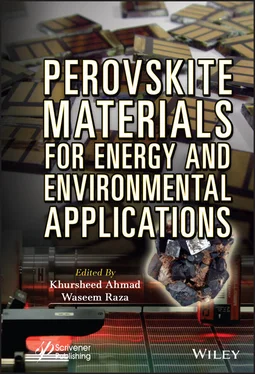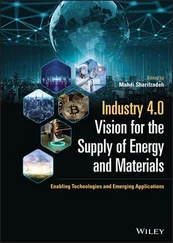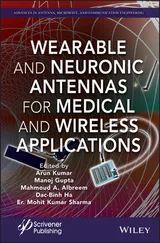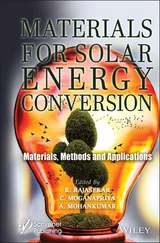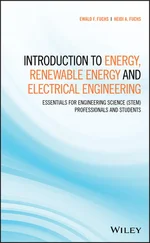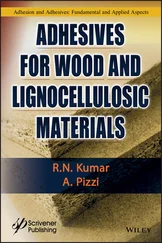Perovskite Materials for Energy and Environmental Applications
Здесь есть возможность читать онлайн «Perovskite Materials for Energy and Environmental Applications» — ознакомительный отрывок электронной книги совершенно бесплатно, а после прочтения отрывка купить полную версию. В некоторых случаях можно слушать аудио, скачать через торрент в формате fb2 и присутствует краткое содержание. Жанр: unrecognised, на английском языке. Описание произведения, (предисловие) а так же отзывы посетителей доступны на портале библиотеки ЛибКат.
- Название:Perovskite Materials for Energy and Environmental Applications
- Автор:
- Жанр:
- Год:неизвестен
- ISBN:нет данных
- Рейтинг книги:5 / 5. Голосов: 1
-
Избранное:Добавить в избранное
- Отзывы:
-
Ваша оценка:
- 100
- 1
- 2
- 3
- 4
- 5
Perovskite Materials for Energy and Environmental Applications: краткое содержание, описание и аннотация
Предлагаем к чтению аннотацию, описание, краткое содержание или предисловие (зависит от того, что написал сам автор книги «Perovskite Materials for Energy and Environmental Applications»). Если вы не нашли необходимую информацию о книге — напишите в комментариях, мы постараемся отыскать её.
The book provides a state-of-the-art summary and discussion about the recent progress in the development and engineering of perovskite solar cells materials along with the future directions it might take.
Audience
Perovskite Materials for Energy and Environmental Applications — читать онлайн ознакомительный отрывок
Ниже представлен текст книги, разбитый по страницам. Система сохранения места последней прочитанной страницы, позволяет с удобством читать онлайн бесплатно книгу «Perovskite Materials for Energy and Environmental Applications», без необходимости каждый раз заново искать на чём Вы остановились. Поставьте закладку, и сможете в любой момент перейти на страницу, на которой закончили чтение.
Интервал:
Закладка:
1.7 Conclusion
From the study of these simulation softwares, it can be definitely said that simulation of perovskite solar cells can be used as a tool for designing and optimizing advanced perovskite solar cell structures and also to interpret the measurements made on different device structures. It can also be conclusively inferred that simulation can bring about better understanding of the detailed specifics of the working of perovskite solar cell structures. However, the simulation of perovskite solar cells requires a lot of input parameters, which makes it a tedious task.
All the softwares discussed here use Graphical User Interface except ASA, which uses ASCII file to input the values of various parameters. The number of layers that can be simulated is fixed in SCAPS and AMPS 1D, whereas there is no such fixation in AFORS-HET and ASA. All softwares studied use SRH recombination mechanism, whereas SCAPS and AMPS 1D also use band-to-band recombination. Auger recombination is considered in SCAPS. All the software studied here give the option to model defects. In SCAPS, up to seven defects can be simulated in any semiconductor layer, and all the parameters of each defect can be modified by “defect properties panel.” AMPS 1D allows Discrete and Banded Defect (Structural and Impurity) Levels and Generalized Defect (Structural and Impurity) Level Distributions. In AFORS-HET, defect distribution of states (DOS) has to be quantified for all layers and for the interfaces. In ASA, both the extended and localized states can be modeled using the defect-pool models. Modeling of tunnelling is available in all the softwares except AMPS 1D. All softwares are capable of doing electrical and spectral response measurements.
References
1. Neamen, D.A., Semiconductor physics and devices: basic principles, McGraw-Hill, New York, 2003.
2. Mandadapu, U., Vedanayakam, S.V., Thyagarajan, K., Babu, B.J., Optimisation of high efficiency tin halide perovskite solar cells using SCAPS-1D. Int. J. Simul. Process Model. , 13, 3, 221–227, 2018.
3. Zeman, M., van den Heuvel, J., Pieters, B.E., Kroon, M., Willemen, J., Advanced semiconductor analysis , TU Delft, Delft, 2003.
4. Pieters, B.E., Krc, J., Zeman, M., May. Advanced numerical simulation tool for solar cells-ASA5, in: 2006 IEEE 4th World Conference on Photovoltaic Energy Conference , vol. 2, IEEE, pp. 1513–1516, 2006.
5. Pieters, BE., Zeman, M., Metselaar, JW., Extraction of the defect density of states of a-Si:H using Q-DLTS. In s.n. (Ed.), Proceedings of the STW annual workshop on semiconductor advances for future electronics and sensors (SAFE 2005) , 38–42, STW, 2005.
6. Zeman, M., Willemen, J.A., Vosteen, L.L.A., Tao, G., Metselaar, J.W., Computer modelling of current matching in a-Si: H/a-Si: H tandem solar cells on textured TCO substrates. Sol. Energy Mater. Sol. Cells , 46, 2, 81–99, 1997.
7. Meier, J., Dubail, S., Fluckinger, R., Fisher, D., Keppner, H., Shah, A., Intrinsic microcrystalline silicon(μc-Si:H)—A promising new thin film solar cell material. In Proceedings of the 1st World Conference on Photovoltaic energy conversion , Waikoloa, HI, USA, 5–9, December 1994.
8. Yamamoto, K., Yoshimi, M., Tawada, Y., Fukuda, S., Sawada, T., Meguro, T., Takata, H., Suezaki, T., Koi, Y., Hayashi, K., Suzuki, T., Large area thin film Si module. Sol. Energy Mater. Sol. Cells , 74, 1-4, 449–455, 2002.
9. Nádazdy, V., Durný, R., Pincik, E., Evidence for the improved defect-pool model for gap states in amorphous silicon from charge DLTS experiments on undoped a-Si: H. Phys. Rev. Lett. , 78, 6, 1102, 1997.
10. Nádaždy, V. and Thurzo, I., A model of the small-signal charge DLTS response of traps distributed in both energy and space. Phys. Status Solidi (a) , 127, 1, 167–177, 1991.
11. Springer, J., Poruba, A., Mullerova, L., Vanecek, M., Reetz, W., Muller, J., 3-dimensional optical model for thin film silicon solar cells. 3rd World Conference on Photovoltaic Energy Conversion, Proceedings of, 2003 , vol. 2, pp. 1827–1830, 2003.
12. Krč, J., Smole, F., Topič, M., Potential of light trapping in microcrystalline silicon solar cells with textured substrates. Prog. Photovolt: Res. Appl. , 11, 429–436, 2003, https://doi.org/10.1002/pip.506.
13. Fonash, S., Arch, J., Cuiffi, J., Hou, J., Howland, W., McElheny, P., Moquin, A., Rogosky, M., Tran, T., Zhu, H., A manual for AMPS-1D for windows 95/NT a one-dimensional device simulation program for the analysis of microelectronic and photonic structures , The Pennsylvania State University, USA, 1997.
14. Zhu, H., Kalkan, A.K., Hou, J., Fonash, S.J., Applications of AMPS-1D for solar cell simulation. AIP Conference Proceedings , vol. 462, pp. 309–314, 1999, https://doi.org/10.1063/1.57978.
15. Dennai Benmoussa, M. and Boukais, H.B., Simulation of hetero-junction (GaInP/GaAs) solar cell using AMPS-1D. J. Nano- Electron. Phys. , 8, 1, 01009, 2016.
16. Hossain, E.S., Chelvanathan, P., Shahahmadi, S.A., Sopian, K., Bais, B., Amin, N., Performance assessment of Cu2SnS3 (CTS) based thin film solar cells by AMPS-1D. Curr. Appl. Phys. , 18, 1, 79–89, 2018, https://doi.org/10.1016/j.cap.2017.10.009.
17. Stangl, R., Kriegel, M., Schmidt, M., AFORS-HET, Version 2.2, a numerical computer program for simulation of heterojunction solar cells and measurements, in: 2006 IEEE 4th World Conference on Photovoltaic Energy Conference , vol. 2, IEEE, pp. 1350–1353, 2006, May.
18. Stangl, R., Kriegel, M., Maydell, K.V., Korte, L., Schmidt, M., Fuhs, W., AFORS-HET, an open-source on demand numerical PC program for simulation of (thin film) heterojunction solar cells, version 1.2, in: Conference Record of the Thirty-first IEEE Photovoltaic Specialists Conference , IEEE, pp. 1556–1559, 2005, January2005.
19. Wurfel, P., The chemical potential of radiation. J. Phys. C: Solid State Phys. , 15, 3967, 1982.
20. Fuhs, W., Korte, L., Schmidt, M., Heterojunctions of hydrogenated amorphous silicon and monocrystalline silicon. J. Optoelectron. Adv. Mat. , 8, 6, 1989–1995, 2006.
21. Gudovskikh, A.S., Kleider, J.P., Stangl, R., New approach to capacitance spectroscopy for interface characterization of a-Si: H/c-Si heterojunctions. J. Non-Cryst. Solids , 352, 9-20, 1213–1216, 2006.
22. Gudovskikh, A.S., Kleider, J.P., Froitzheim, A., Fuhs, W., Terukov, E.I., Investigation of a-Si: H/c-Si heterojunction solar cells interface properties. Thin Solid Films , 451, 345–349, 2004.
23. Schaffarzik, D., Stangl, R., Laades, A., Schubert, C., Schmidt, M., Recombination analysis at the n-doped a-Si: H (n)/c-Si (p) heterojunction by means of time and intensity dependent surface photovoltage, in: Proc. PVSEC-20, 20th European Photovoltaic Conference , 2005, June.
24. Maydell, K.V., Conrad, E., Schmidt, M., Efficient silicon heterojunction solar cells based on p- and n-type substrates processed at temperatures < 220 C. Prog. Photovolt: Res. Appl. , 14, 289–295, 2006, https://doi.org/10.1002/pip.668.
25. Stangl, R., Kriegel, M., Schaffarzik, D., Schmidt, M., AFORS-HET, Version 2.1, a numerical computer program for simulation of (thin film) heterojunction solar cells, in: Proc. 15th Int. Photovoltaic Sci. Eng. Conf , pp. 985–986, 2005, October.
26. Stangl, R., Froitzheim, A., Kriegel, M., Brammer, T., Kirste, S., Elstner, L., ... Fuhs, W., AFORS-HET, a numerical PC-program for simulation of heterojunction solar cells, Version 1.1 (open-source on demand), to be distributed for public use. Proc. 19th PVSEC , Paris, France, 1497, 2004.
27. Burgelman, M., Nollet, P., Degrave, S., Modelling polycrystalline semiconductor solar cells. Thin solid films , 361, 527–532, 2000.
Читать дальшеИнтервал:
Закладка:
Похожие книги на «Perovskite Materials for Energy and Environmental Applications»
Представляем Вашему вниманию похожие книги на «Perovskite Materials for Energy and Environmental Applications» списком для выбора. Мы отобрали схожую по названию и смыслу литературу в надежде предоставить читателям больше вариантов отыскать новые, интересные, ещё непрочитанные произведения.
Обсуждение, отзывы о книге «Perovskite Materials for Energy and Environmental Applications» и просто собственные мнения читателей. Оставьте ваши комментарии, напишите, что Вы думаете о произведении, его смысле или главных героях. Укажите что конкретно понравилось, а что нет, и почему Вы так считаете.
